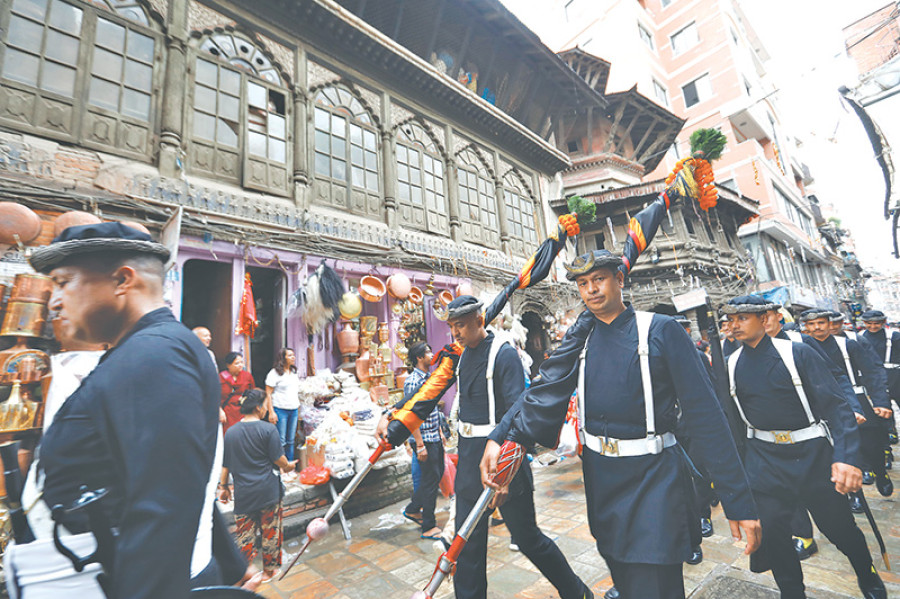Miscellaneous
A Postcard from Paltan Ghar
At face value, the Paltan Ghar in Asan is one more intriguing historical building in the Valley that is in dire want of upkeep.
Sanjit Bhakta Pradhananga
At face value, the Paltan Ghar in Asan is one more intriguing historical building in the Valley that is in dire want of upkeep. Hugging one of the six streets that feed into Asan Chowk, were this avant-garde 240-year-old building not caked by dust or camouflaged by the brass pots that line its walls, it would perhaps have been one of the most photographed quarters of old Kathmandu. But as it stands, as a privately-owned building bound to heritage conservation laws, Paltan Ghar has remained in a strange limbo for many decades—receding further into obscurity each year even as the neighbourhood around it twists and contorts towards the sky.
To call the Paltan Ghar a palace might be a stretch—though surely not by much. With an expansive complex that once opened up into eight different courtyards, this after all used to be one of the largest family homes besides the durbars themselves. Strategically located at equal distance from both the royal palace at Basantapur and the main entrance into the walled city at Bhotahity, the Paltan Ghar was occupied by Abhiman Singh Basnyat—the first commander of a unified Nepali army—following the sacking of Kathmandu in 1768. Here, as his family prospered and multiplied, he ordered a new wing to the Malla-era complex be built. This building, when completed in 1777, boasted a lavish Baithak lined by seven Mughal-inspired stained-glass windows—the first for a private home in the country. Below them, fresco reliefs of 72 soldiers marched across the building’s facade—one for each man, as a legend puts it, that sacked Kathmandu on an inebriated Indra Jatra midnight.
Though steeped in fascinating history, Paltan Ghar is not, however, just an edifice to one man’s victories or vanities. True to a city that has been built layer upon layer, this tiny corner of Kathmandu too peels away its stories like a willingly onion, even if much of it remains little more than hyperbole and conjecture.

Take for instance the fact that it has been a long while since the last Basnyat family actually lived at the Paltan Ghar. For two and a half centuries, this labyrinthine complex has changed hands numerous times—carved up and sold off each time a new wave of migration or exodus reshaped the city at large; with each new tenant moving in hoping to strike it big at what was (and maybe still is) the busiest marketplace in the land.
One such group of migrants, the Joshi clan—an enterprising Bhaktapuri business family—pitched their roots in at the oldest wing of the complex at the turn of the 20th century with a simple business plan in mind. They would sell metal, primarily iron bought on the cheap at auctions, to smiths, then buy back the utensils and tools they created. These karais, spades and hoes would then be distributed for a profit to vendors at the marketplace outside.The idea stuck and business flourished. Soon the neighbourhood was drawing Kamis from as far away as Rasuwa and Dolakha, while other merchants moved in to emulate the fortunes of the Phalam Sahus. Starting out with just household utensils and farming tools, these stores evolved to eventually having pipes, faucets, chains, mousetraps and sundry on offer as well, becoming a veritable hub for the city’s hardware needs.
It is said that hardware stores mushrooming in locality, like bullfrogs prophesising rain, precede an inevitable boom in construction. So, it is perhaps of little surprise that it was these vendors from the Paltan Ghar neighbourhood who were some of the first merchants to dabble with alternate construction materials—from corrugated metal sheets to concrete. One Nan’s tale even goes as far as to claim that cement was used for the first time [in a private residence in the Valley] on one of the inner wings of the Paltan Ghar complex.
Today, whether you see this as a necessary leap towards modernity or the original sin, you can’t help but feel it has all come a full circle at the Paltan Ghar. Asan is now changing faster than ever before as more and more residential homes are converted into commercial storefronts and godams; each new construction taller, bolder, more precarious, than the last. Hemmed in by these gangly, concrete structures that are cashing in on their prime location, the Paltan Ghar is the one of the few houses in the locale that can’t be knocked down. As a 100-year-old heritage building, the law mandates that if the house is demolished, it be built back in the exact form, using the same technology as the original. And while that might sound astute in the long run, in an age of instant turnovers, it holds little appeal to the building’s stakeholders.
Which is why, even as the neighbourhood around it transforms into a sea of steel and concrete, Paltan Ghar remains trapped in a time warp. Caked in a thick layer of dust, camouflaged by the brass pots that line its walls, it is a strange purgatory of sorts—a Janus caught in the headlights, neither able to reclaim the glories of yore nor free to chart a new course of its own.




 8.12°C Kathmandu
8.12°C Kathmandu








%20(1).jpg&w=300&height=200)

